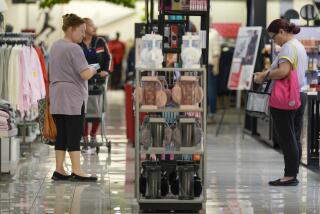Sizzling Economy May Be Cooling
WASHINGTON — The economy grew at its hottest pace in 2 1/2 years in the opening quarter of 2006, but signs suggest that it has cooled since then.
The Commerce Department reported Thursday that economic activity expanded at a 5.6% annual rate in the January-to-March period. The revised reading on gross domestic product was an even stronger showing than the 5.3% pace estimated for the quarter a month ago.
The new estimate -- based on more complete information -- matched economists’ forecasts.
The stronger GDP figure mostly reflected an improvement in the country’s trade deficit, which was much less of a drag than previously estimated.
Gross domestic product measures the value of all goods and services produced within the United States and is considered the best indicator of the country’s economic fitness.
Fresher barometers, however, suggest the economy is slowing.
The Labor Department said new claims filed for unemployment benefits last week rose by 4,000 to 313,000 -- a bit more than economists had expected.
Analysts believe economic growth in the April-to-June quarter could turn out to be half the pace of the first quarter’s. They are predicting growth of 2.5% to 3%. High energy prices and a more moderate housing market will play roles in the expected slowdown.
“I think the economy is moving from a boil to a simmer,” said Richard Yamarone, an economist at Argus Research.
If that turns out to be the case, the economy will have registered a seesaw-like pattern of growth in the last few quarters.
The opening quarter’s energetic performance followed a lethargic showing in the fourth quarter, when the economy grew by a feeble 1.7%. Fallout from the Gulf Coast hurricanes, including high energy prices, prompted belt-tightening by people and businesses.
Consumers and businesses came roaring back in the first quarter, a main reason the overall economy performed so well.
Consumers boosted spending in the first quarter at a 5.1% pace, compared with a meager 0.9% growth rate in the fourth quarter.
Businesses ramped up spending on equipment and software at a brisk 14.8% pace, up from a 5% growth rate in the previous quarter.
And companies’ profits continued to grow briskly. One measure in the GDP report showed after-tax profits rose 13.8% in the first quarter. It was the second consecutive quarter of such strong growth.
The trade picture improved because imports grew less than previously estimated. That meant the trade deficit shaved only 0.24 percentage point from GDP, compared with a 0.55-percentage-point reduction calculated a month ago.
In a third report, America’s net debtor position deteriorated last year, with foreigners owning $2.69 trillion more in U.S. assets such as stocks, bonds and real estate than Americans own in foreign assets. In 2004, the investment gap totaled $2.36 trillion.
An inflation gauge closely watched by the Federal Reserve showed that core prices -- excluding food and energy -- rose 2% in the first quarter. That was the same as last month’s estimate and was down from 2.4% in the fourth quarter.
The inflation reading, however, was taken before oil prices shot up to a record $75.17 a barrel in late April. They are now hovering above $72 a barrel.
More to Read
Inside the business of entertainment
The Wide Shot brings you news, analysis and insights on everything from streaming wars to production — and what it all means for the future.
You may occasionally receive promotional content from the Los Angeles Times.










